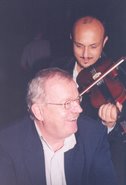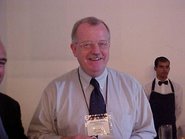 "...communication is not just one element in the struggle to make science relevant. It is the central element. Because if you gather scientific knowledge but are unable to convey it to others in a correct and compelling form, you might as well not even have bothered to gather the information.” This quote comes from the latest publication of marine biologist and film maker Randy Olsen: ‘Don’t be such a scientist: talking substance in an age of style’, Island Press 2009. In this book Olsen argues that scientists should pay more attention to how they communicate their work. They should focus not only on substance or content, but much more on the style of communication. As a professor in marine biology, Olsen had gained a reputation on a range of conservation issues. But only as a film maker he learned that information, facts and figures do not speak for themselves. At least when you are not teaching students or talking to your peers. Olsen explains how human psychology basically works. In the matrix I present my personal summary of his explanation. To get people – non-experts – to listen to your research or project findings, you have to first stimulate curiosity in them. You do that not through content but through style: humor, spontaneity, personal stories and messages. Only after you have ‘aroused’ your audience they are open for the content. Or in Olsen’s words: “When it comes to connecting with the entire audience you have four bodily organs that are important: your head, your heart, your gut, and your sex organs. The object is to move the process down out of your head, into your heart with sincerity, into your gut with humor, and , ideally if you’re sexy enough, into your lower organs with sex appeal.“
"...communication is not just one element in the struggle to make science relevant. It is the central element. Because if you gather scientific knowledge but are unable to convey it to others in a correct and compelling form, you might as well not even have bothered to gather the information.” This quote comes from the latest publication of marine biologist and film maker Randy Olsen: ‘Don’t be such a scientist: talking substance in an age of style’, Island Press 2009. In this book Olsen argues that scientists should pay more attention to how they communicate their work. They should focus not only on substance or content, but much more on the style of communication. As a professor in marine biology, Olsen had gained a reputation on a range of conservation issues. But only as a film maker he learned that information, facts and figures do not speak for themselves. At least when you are not teaching students or talking to your peers. Olsen explains how human psychology basically works. In the matrix I present my personal summary of his explanation. To get people – non-experts – to listen to your research or project findings, you have to first stimulate curiosity in them. You do that not through content but through style: humor, spontaneity, personal stories and messages. Only after you have ‘aroused’ your audience they are open for the content. Or in Olsen’s words: “When it comes to connecting with the entire audience you have four bodily organs that are important: your head, your heart, your gut, and your sex organs. The object is to move the process down out of your head, into your heart with sincerity, into your gut with humor, and , ideally if you’re sexy enough, into your lower organs with sex appeal.“
Saturday, 25 September 2010
Communicating science
 "...communication is not just one element in the struggle to make science relevant. It is the central element. Because if you gather scientific knowledge but are unable to convey it to others in a correct and compelling form, you might as well not even have bothered to gather the information.” This quote comes from the latest publication of marine biologist and film maker Randy Olsen: ‘Don’t be such a scientist: talking substance in an age of style’, Island Press 2009. In this book Olsen argues that scientists should pay more attention to how they communicate their work. They should focus not only on substance or content, but much more on the style of communication. As a professor in marine biology, Olsen had gained a reputation on a range of conservation issues. But only as a film maker he learned that information, facts and figures do not speak for themselves. At least when you are not teaching students or talking to your peers. Olsen explains how human psychology basically works. In the matrix I present my personal summary of his explanation. To get people – non-experts – to listen to your research or project findings, you have to first stimulate curiosity in them. You do that not through content but through style: humor, spontaneity, personal stories and messages. Only after you have ‘aroused’ your audience they are open for the content. Or in Olsen’s words: “When it comes to connecting with the entire audience you have four bodily organs that are important: your head, your heart, your gut, and your sex organs. The object is to move the process down out of your head, into your heart with sincerity, into your gut with humor, and , ideally if you’re sexy enough, into your lower organs with sex appeal.“
"...communication is not just one element in the struggle to make science relevant. It is the central element. Because if you gather scientific knowledge but are unable to convey it to others in a correct and compelling form, you might as well not even have bothered to gather the information.” This quote comes from the latest publication of marine biologist and film maker Randy Olsen: ‘Don’t be such a scientist: talking substance in an age of style’, Island Press 2009. In this book Olsen argues that scientists should pay more attention to how they communicate their work. They should focus not only on substance or content, but much more on the style of communication. As a professor in marine biology, Olsen had gained a reputation on a range of conservation issues. But only as a film maker he learned that information, facts and figures do not speak for themselves. At least when you are not teaching students or talking to your peers. Olsen explains how human psychology basically works. In the matrix I present my personal summary of his explanation. To get people – non-experts – to listen to your research or project findings, you have to first stimulate curiosity in them. You do that not through content but through style: humor, spontaneity, personal stories and messages. Only after you have ‘aroused’ your audience they are open for the content. Or in Olsen’s words: “When it comes to connecting with the entire audience you have four bodily organs that are important: your head, your heart, your gut, and your sex organs. The object is to move the process down out of your head, into your heart with sincerity, into your gut with humor, and , ideally if you’re sexy enough, into your lower organs with sex appeal.“
Tuesday, 21 September 2010
Behavior is less rational than we may think
 We tend to make ‘hot’ choices – “what I want to have”, over ‘cold’ choices – “who I want to be”. Satisfying immediate needs is an instinct humans share with animals: (fast) food, sex, power, whatever turns you on. Civilization has also brought other values, says psychologist Roos Vonk, but mostly those moral values lose from our instincts. We consume on impulses to satisfy our immediate desires. Even if it means compromising our moral values of fair trade, child labor, CO2 and ecological footprints, health etc. Unconsciously our mind ‘explains away’ the potential objections from our consciousness, so that we still can feel good, whatever choice we make.
We tend to make ‘hot’ choices – “what I want to have”, over ‘cold’ choices – “who I want to be”. Satisfying immediate needs is an instinct humans share with animals: (fast) food, sex, power, whatever turns you on. Civilization has also brought other values, says psychologist Roos Vonk, but mostly those moral values lose from our instincts. We consume on impulses to satisfy our immediate desires. Even if it means compromising our moral values of fair trade, child labor, CO2 and ecological footprints, health etc. Unconsciously our mind ‘explains away’ the potential objections from our consciousness, so that we still can feel good, whatever choice we make. Firstly our mind acts like a spin doctor when dealing with cognitive dissonancy: “For a healthy diet I simply need to eat meat”; “meat is just delicious, I can’t imagine a meal without it”; “I already do so much for the environment”; “Biological products are far too expensive”; “I only eat biological meat or buy fair trade products” Etc.
Secondly our mind unconsciously appeals to the paradigm of individualism: “I want to do my thing”, “I have a right to live and consume the way I prefer”, “I am free to choose what makes me happy”; “I happen to like buying new stuff”; “I do what is good for me”; “I follow my gut feelings and instincts” Etc.
Thirdly our mind appeals to dominant social and moral values: “it is not immoral to eat meat, to fly etc.”; “There is no law against…”; “The government acts in the same way”.
In communicating sustainability Roos argues it is best to address the hot choices by appealing to cold the ones: “do you have an inferiority complex that you need to drive a Hummer?”; “If you consume like others, is that compatible with your personal values?”; “Isn’t it the core of individual freedom to pursue the values you belief in?”
Monday, 20 September 2010
How sexy are forests?
 Psychology is at work when we are confronted with words. Words have not only their literal or dictionary meaning, they also have strong associative connotations. A word invokes feelings, images, memories and values. People in the disciplines of journalism or advertizing know how much words matter. Choose the wrong words in your headline or tagline and no one will read your article or buy your product. To illustrate how this works for the word forest, I did a little experiment with forest experts, CEC members and people for whom forest conservation is not of immediate concern. All were asked their first associations with the word ‘forest’. In the matrix I summarize the associations and clustered them into the domains of head, heart, guts and loins.
Psychology is at work when we are confronted with words. Words have not only their literal or dictionary meaning, they also have strong associative connotations. A word invokes feelings, images, memories and values. People in the disciplines of journalism or advertizing know how much words matter. Choose the wrong words in your headline or tagline and no one will read your article or buy your product. To illustrate how this works for the word forest, I did a little experiment with forest experts, CEC members and people for whom forest conservation is not of immediate concern. All were asked their first associations with the word ‘forest’. In the matrix I summarize the associations and clustered them into the domains of head, heart, guts and loins.The associations of most forest experts were in the domain of the brain. Some really tried to be ‘without a mistake’ in their answer, e.g. “Forest is a land which is dominantly covered by trees of different dimensions, in association with grasses, herbaceous plant, lianas and other flora such as epiphytes.” Only a few forest experts had some associations in the domain of the heart, one in the domain of the guts. The answers of CEC members were spread over the domains of brain, heart and guts. The great majority of the associations of the non experts were only in the lower three domains. This is where scientists need professional communicators when addressing non-experts: with style, storytelling, messaging, and tone of voice that appeals to the audience they want to reach. An article on this experiment will be published in Arbor Vitae.
CEPA Toolklit Users Survey
 As contribution to the International Year of Biodiversity, HECT consultancy did a survey among users of the CEPA toolkit to explore how to improve biodiversity communication. Respondents are highly satisfied with the toolkit. They like the perspective of change and the orientation on biodiversity results. Its comprehensiveness makes that different professions find tools in it, which they can immediately use. Many respondents have recommended the toolkit in their professional networks, as a credible and authorative source of information. They also indicate that SCBD and IUCN should invest more in PR and distributionn of the toolkit to bring it to the attention of national policymakers and local conservation initiatives.
As contribution to the International Year of Biodiversity, HECT consultancy did a survey among users of the CEPA toolkit to explore how to improve biodiversity communication. Respondents are highly satisfied with the toolkit. They like the perspective of change and the orientation on biodiversity results. Its comprehensiveness makes that different professions find tools in it, which they can immediately use. Many respondents have recommended the toolkit in their professional networks, as a credible and authorative source of information. They also indicate that SCBD and IUCN should invest more in PR and distributionn of the toolkit to bring it to the attention of national policymakers and local conservation initiatives. At the other hand the comprehensiveness also makes it difficult to easily find what one looks for, both in the hard copy and in the electronic version. Especially the latter is not very user-friendly. There is a need for even more information tailored to local and cultural contexts, exchange of experiences and case studies. Respondents also express a demand for more training workshops and distance education to fully take advantage of all the information and tools. The survey will be published in the coming weeks by IUCN and SCBD.
Thursday, 2 September 2010
Oil becomes Plastic becomes Oil
A story of positive change starts with the inventor remembering how in his youth he used to play in nature. Tina Trampus, a colleague, made me aware of this video. Since it first appeared on YouTube it already had over 150.000 views. It caused controversy about assumed toxic residues and the disincentive to reduce the use of plastic. The UNU page now provides arguments that it is safe. The company still mainly produces larger, industrial-use machines: info@blest.co.jp.
Subscribe to:
Comments (Atom)








